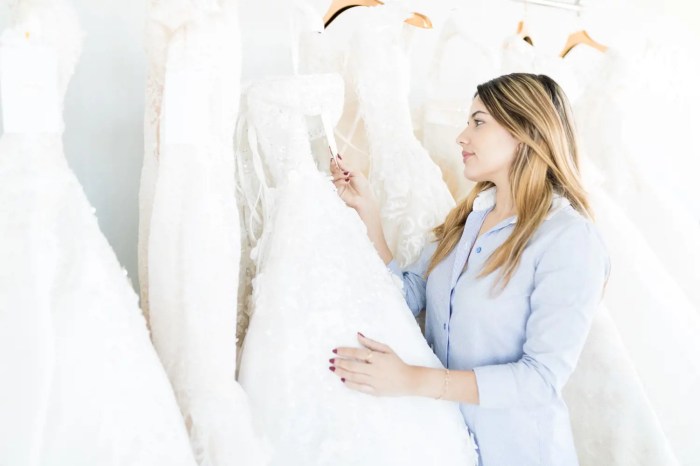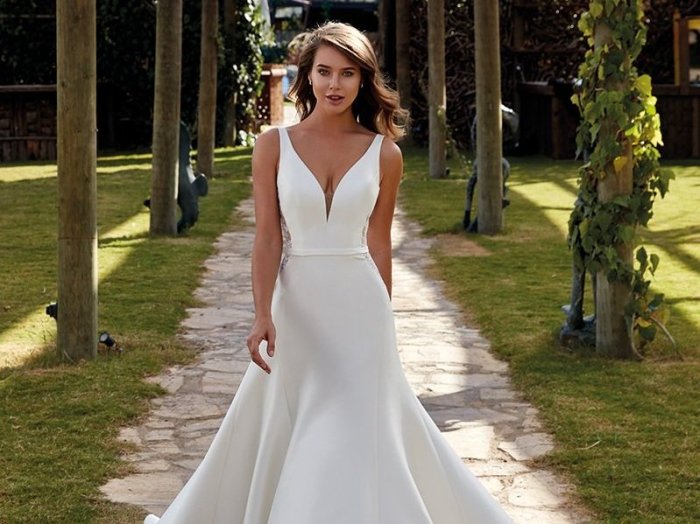How Much Are Custom Wedding Dresses?
Factors Affecting Custom Wedding Dress Costs: How Much Are Custom Wedding Dresses
How much are custom wedding dresses – The price of a custom wedding dress is influenced by a multitude of factors, each contributing significantly to the final cost. Understanding these factors allows brides to make informed decisions and manage their budget effectively. This section details the key elements that determine the overall expense.
Fabric Selection and Cost
Fabric choice significantly impacts the price. High-end fabrics like silk charmeuse, silk organza, and French lace command higher prices due to their quality, texture, and luxurious feel. Conversely, more budget-friendly options include satin, chiffon, and taffeta. The drape, weight, and overall aesthetic of the fabric also influence the design possibilities and the complexity of construction, further affecting the cost.
| Fabric Type | Price Range Per Yard | Durability | Suitability for Styles |
|---|---|---|---|
| Silk Charmeuse | $50-$200+ | Moderate; prone to snags | A-line, sheath, mermaid |
| Silk Organza | $40-$150+ | Moderate; delicate | Ballgown, A-line, romantic styles |
| French Lace | $100-$500+ | Moderate; requires careful handling | Most styles; adds intricate detail |
| Satin | $10-$50 | High; relatively easy to care for | A-line, sheath, mermaid |
| Chiffon | $5-$30 | Moderate; delicate | Flowing styles, bohemian gowns |
| Taffeta | $10-$40 | High; durable and holds shape well | Ballgown, A-line, structured styles |
Embellishments and Their Cost Implications

Source: captaincash.ca
Embellishments like beading, lace appliqués, embroidery, and sequins add significant cost to a custom dress. The intricacy and density of these embellishments directly correlate with the price. For instance, hand-beaded gowns can cost thousands more than a simpler design.
- Hand-beading: $500-$5000+ per dress, depending on the density and intricacy.
- Lace appliqués: $100-$1000+ depending on the type and quantity of lace used.
- Embroidery: $200-$2000+ depending on the design complexity and the type of thread.
Designer vs. Independent Seamstress: A Cost Comparison
Choosing between a renowned designer and an independent seamstress significantly impacts the final price and the overall experience. Both options offer unique advantages and disadvantages concerning cost, design capabilities, and personalization.
Comparing Pricing and Services
- Established Designers: Typically charge higher prices reflecting their brand recognition, expertise, and use of high-quality materials. Expect prices ranging from $5,000 to $20,000 or more.
- Independent Seamstresses: Generally offer more affordable options, with prices ranging from $1,000 to $5,000 depending on complexity and materials. They often provide a higher level of personalized attention.
Pros and Cons of Each Option
- Designer:
- Pros: Established reputation, access to high-end materials, extensive design expertise.
- Cons: High cost, potentially less personalized attention, less flexibility in design alterations.
- Seamstress:
- Pros: More affordable, greater design flexibility, higher level of personalized attention.
- Cons: Less brand recognition, potentially limited access to high-end materials, less experience with complex designs.
Budgeting and Planning for Your Custom Dress
Creating a detailed budget and plan is crucial for managing the cost of a custom wedding dress. This involves careful consideration of all expenses, from initial consultations to final alterations. Thorough planning minimizes surprises and ensures a smooth process.
Step-by-Step Budgeting Guide
- Initial Consultation: Set aside funds for the initial consultation fee (often waived if you proceed with the dressmaker).
- Fabric and Materials: Allocate a budget for the chosen fabrics, embellishments, and other materials.
- Design and Construction: Factor in the designer’s or seamstress’s fees, which can vary greatly depending on experience and complexity.
- Fittings: Include costs for multiple fittings, which are essential for achieving a perfect fit.
- Alterations: Allocate funds for potential alterations after the initial creation of the dress.
- Contingency Fund: Always include a contingency fund to cover unforeseen expenses.
Questions to Ask Potential Dressmakers

Source: pritchettbridal.com
- What is your experience with custom wedding dresses?
- Can you provide examples of your previous work?
- What is your pricing structure and payment schedule?
- What is your turnaround time?
- What is your alteration policy?
Sample Budget Spreadsheet, How much are custom wedding dresses
This is a textual representation, not actual spreadsheet code:
Category | Estimated Cost | Actual Cost
The cost of custom wedding dresses varies greatly, depending on designer, fabric, and embellishments. Naturally, the number of guests also influences the overall budget, as you’ll want to consider the overall aesthetic and how your dress complements the guests at wedding dresses. Ultimately, the price of a custom gown depends on your vision and how much you’re willing to invest to make it a reality.
Therefore, planning ahead and setting a realistic budget is key.
Consultation Fee | $100 | $100
Fabric | $800 | $750
Design & Construction | $2000 | $2100
Fittings | $200 | $250
Alterations | $300 | $200
Contingency | $500 | $0
Total | $3900 | $3600
Illustrating Design Choices and Their Cost Implications
The design elements of a wedding dress significantly influence the final cost. Specific choices regarding silhouette, fabric, embellishments, and alterations directly impact both the aesthetic and the price.
Design Styles and Associated Costs
- A-Line Gown: A classic and versatile style, generally less expensive than more elaborate designs. Variations in fabric and embellishments will affect the cost.
- Ballgown: This voluminous style often requires more fabric and intricate construction, resulting in a higher price. The amount and type of embellishments will increase the cost.
- Mermaid Gown: This form-fitting silhouette can be more expensive due to the complexity of construction and the need for precise fitting. Adding a train or embellishments further increases the cost.
Fabric Details and Suitability
- Silk: Luxurious and drapes beautifully, making it ideal for various styles. It comes in a wide price range depending on the type (charmeuse, organza, etc.).
- Lace: Adds intricate detail and texture, significantly impacting cost depending on the type (French lace being the most expensive). It’s suitable for many styles but requires careful handling.
- Tulle: A lightweight and versatile fabric, often used for skirts and overlays. It is a relatively affordable option, perfect for ballgowns and romantic styles.
Alterations and Their Cost
Alterations such as adding sleeves, changing the neckline, or adjusting the train length can add to the final cost. The complexity of the alteration and the amount of time required will determine the price.
Finding and Selecting a Reputable Custom Dressmaker

Source: squarespace-cdn.com
Finding the right designer or seamstress is crucial for a successful custom dress experience. This involves thorough research, careful consideration of portfolios, and clear communication regarding design preferences and budget.
Resources for Finding Dressmakers
- Online Directories: Websites specializing in wedding vendors often feature listings of designers and seamstresses.
- Wedding Blogs and Magazines: These publications often feature articles and recommendations for reputable dressmakers.
- Word-of-Mouth Referrals: Ask friends, family, or wedding planners for recommendations.
- Local Bridal Shops: Some bridal shops may have relationships with local designers or seamstresses.
Reviewing Portfolios and Testimonials
Thoroughly examine the designer’s or seamstress’s portfolio to assess their design style and craftsmanship. Reading testimonials from previous clients provides valuable insights into their professionalism, communication style, and overall experience.
Selecting a Dressmaker: Key Considerations
- Communication Style: Ensure clear and open communication throughout the process.
- Design Aesthetic: Choose a designer or seamstress whose style aligns with your vision.
- Contract Terms: Review the contract carefully, paying attention to payment schedules, alteration policies, and deadlines.
Questions Often Asked
Can I pay for a custom wedding dress in installments?
Many designers and seamstresses offer payment plans. It’s crucial to discuss payment options and terms upfront during your initial consultation.
What happens if I need significant alterations after the initial fitting?
Most designers include a certain number of alterations in their pricing. However, extensive changes beyond the initial agreement may incur additional costs. Clarify alteration policies before committing to a dressmaker.
How long does it typically take to create a custom wedding dress?
The timeframe varies depending on the complexity of the design and the designer’s workload. Expect a minimum of several months, sometimes longer, particularly for intricate designs or during peak seasons.
What should I do if I’m unhappy with the final product?
A well-defined contract should Artikel expectations and dispute resolution processes. Before signing any contract, ensure it addresses potential issues and Artikels clear solutions.
















